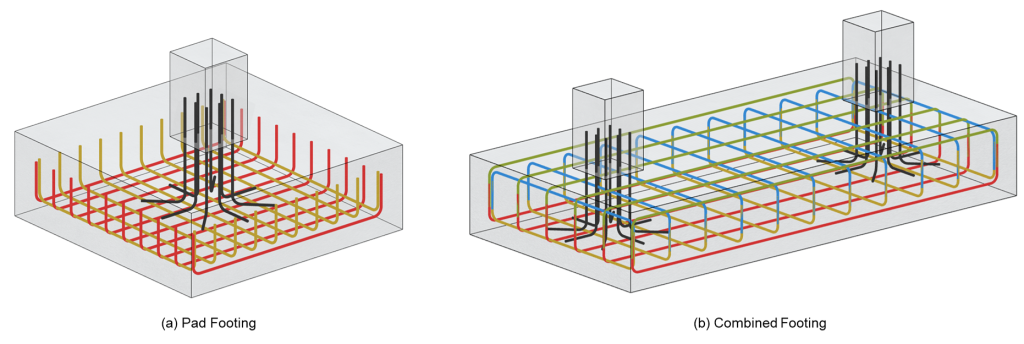Inhaltsverzeichnis
- Understanding Rebar Development Length in Pad Footings
- Länge der Kompressionsentwicklung
- Länge der Spannungsentwicklung
- Designmodul der SkyCiv Foundation
This documentation explores the significance of rebar development length in concrete footings and its role in ensuring structural integrity. You can gain insights into design code requirements, factors that influence development length, and practical approaches for incorporating them into your footing designs. Plus, discover how the SkyCiv Foundation Design module simplifies the process of verifying rebar development length for your projects.
Understanding Rebar Development Length in Pad Footings
Proper anchorage and reinforcement are essential for the stability and longevity of concrete structures, especially in pad footings. Development length is the minimum length of rebar embedded in the concrete necessary to achieve the required bond strength between steel and concrete. A development length check ensures that reinforcement is adequately embedded to resist loads without slipping, maintaining structural integrity and enabling safe load transfer to the ground. Verifying development length is a key part of footing design, assuring performance under static and dynamic loads and safeguarding overall structure stability.
Different design standards provide specific guidelines for determining these lengths to ensure that reinforcing bars are securely anchored within the concrete. This article provides an overview of the footing development length requirements as specified by various design standards, einschließlich ACI 318-14 (Amerikanisches Betoninstitut), AS 3600 (Australische Standards), CSA (Canadian Standards Association), und EN (Eurocode). By examining the distinct approaches and criteria set forth by each standard, engineers can better understand how to apply these guidelines effectively in practice, ensuring robust and compliant structural designs.
Länge der Kompressionsentwicklung
The compression development length of a footing is a crucial factor in determining its required thickness to ensure proper anchorage of reinforcing bars. This length is calculated based on the need to embed the bars sufficiently within the concrete to achieve adequate bond strength and prevent slippage under compressive loads. Incorporating the correct development length allows engineers to design footings with optimal thickness for reinforcement, ensuring structural stability and durability and enhancing overall safety.
Amerikanisches Betoninstitut (ACI 318 Sektion 25.4.9)
Metrisch:
fj = Bewehrungsrendite Stärke (MPa, psi)
f’c = Betonstärke (MPa, psi)
db = Dübelstangendurchmesser (mm, im)
ѱ r = Confinement reinforcement factor (Tabelle 25.4.9.3)
ƛ = Betontypfaktor (Tabelle 25.4.9.3)
Australisches Handbuch für Bauingenieure (AS 3600 Sektion 13.1.5)
Grundlegende Entwicklungslänge:
fseine = Bewehrungsrendite Stärke (MPa)
fc‘ = Betonstärke
db = Starterstangendurchmesser (mm)
Canadian Standard Association (CSA Section 12.3)
fj = Bewehrungsrendite Stärke (MPa)
fc‘ = Betonstärke
db = Dübelstangendurchmesser (mm)
Eurocode (EN Section 8.4)
Grundlänge der Anchorage (8.4.3)
fj = Bewehrungsrendite Stärke (MPa)
fBd = Ultimativer Bindungsstress (MPa)
σSD = Konstruktionsspannung der Stange an der Position, von der aus dem Verankerung gemessen wird (MPa)
ɸ = Dowel bar diameter (mm)
Verankerungslänge (8.4.4)
ein1, ein2, ein3, ein4 = 1.0 for Compression (Tabelle 8.2)
Minimum anchorage length (8.4.4)
Länge der Spannungsentwicklung
The tension development length is key to ensuring that a footing’s dimensions are adequate to anchor reinforcement against tensile forces. This length, calculated to achieve the necessary bond strength between concrete and rebar, directly impacts the footing’s size and design. Properly determining the tension development length allows engineers to design footings capable of securely anchoring the reinforcement, enabling the structure to withstand tensile stresses and maintain stability and performance.
Amerikanisches Betoninstitut (ACI 318 Sektion 25.4)
Gerade Balken (Sektion 25.4.2.3)
Metrisch:
Wo:
ѱt = Casting position factor (Tabelle 25.4.2.4)
ѱe = Bar coating factor (Tabelle 25.4.2.4)
ѱs = Bar size factor (Tabelle 25.4.2.4)
cb = Mindestabstange Abstand (mm, im)
K.tr = Querverstärkungsindex (mm, im)
(cb + K.tr) / db ≤ 2.5
Standard -Hakenstangen (Sektion 25.4.3.1)
Metrisch:
Wo:
ѱe = Bar coating factor (Tabelle 25.4.3.2)
ѱc = Bar concrete cover factor (Tabelle 25.4.3.2)
ѱr = Confining reinforcement factor (Tabelle 25.4.3.2)
Australisches Handbuch für Bauingenieure (AS 3600 Sektion 13.1.2.2)
Grundlegende Entwicklungslänge:
k1 = 1.3 für Bewehrung mit mehr als 300 MM Betonguss unterhalb der Bar (1.0 Andernfalls)
k2 = (132 – db)/100
k3 = 1-[0.15(cd – db)/db]
cd = Mindestabstange Abstand (mm)
Gerade Bar:
Standard hook or cog:
Canadian Standard Association (CSA Section 12)
Gerade Balken (Sektion 12.2.3)
k1 = Bar location factor (12.2.4)
k2 = Coating factor (12.2.4)
k3 = Concrete density factor (12.2.4)
k4 = Bar size factor (12.2.4)
Standard -Hakenstangen (Sektion 12.5)
Eurocode (EN Section 8.4)
Grundlänge der Anchorage (8.4.3)
ein1, ein2, ein3, ein4 = values shown in Table 8.2 for bars in tension
Minimum anchorage length (8.4.4)
For a detailed guide on how the SkyCiv Design module verifies development length, refer to the following links:
- Amerikanisches Betoninstitut (ACI 318)
- Australisches Handbuch für Bauingenieure (AS 3600)
- Canadian Standard Association (CSA A23.3)
- Eurocode (IM 1992)
Designmodul der SkyCiv Foundation

The latest update to the SkyCiv Foundation Design module enhances its functionality by introducing the ability to incorporate standard hooked reinforcements, enabling more precise and detailed development length checks. This new feature provides users with greater flexibility by allowing them to customize the reinforcement detailing at each end of the footing bars. Users can now specify reinforcement ends as straight bars, 90-degree hooks (Zahnräder), or 180-degree hooks, catering to various design requirements and standards.

The module also features updated graphics that visually aid in inspecting reinforcement detailing checks. Column dowel or starter bars are now also visible in the 3D graphics. With the newly added solver settings under the Miscellaneous tab, users can toggle to ignore specific design checks, such as development length checks and other advanced solving options.
Möchten Sie die Foundation Design-Software von SkyCiv ausprobieren?? Unser kostenloses Tool ermöglicht Benutzern die Durchführung Betonfundamentberechnungen ohne Download oder Installation!


